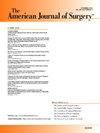Evaluating the effect of hyperbaric oxygen therapy to treat mastectomy skin flap ischemia in breast reconstruction: A single-institution retrospective analysis
IF 2.7
3区 医学
Q1 SURGERY
引用次数: 0
Abstract
Background
Mastectomy skin flap ischemia is a well-known postoperative complication following mastectomy and breast reconstruction. Hyperbaric oxygen therapy (HBOT) has shown promising results for reducing the adverse effects associated with mastectomy skin flap ischemia and associated necrosis; however, there is paucity of literature regarding the indications for HBOT following breast cancer surgery. This study aimed to assess HBOT efficacy in treating and mitigating complications from postoperative tissue ischemia. Secondarily, it explored how patient-related factors may impact the success of HBOT.
Methods
A retrospective analysis was conducted from January 2018 to October 2023. The study analyzed 23 patients at a single institution who were treated with HBOT for diagnosed skin flap ischemia following mastectomy and immediate breast reconstruction. Patient demographics, preoperative, and operative details were collected, as well as postoperative outcomes. The authors deemed HBOT a “success” if there were no major complications and a “failure” if there was ≥1 major complication reported within 6 months following the last HBOT treatment. Logistic regression modeled the odds of HBOT success as a function of patient characteristics.
Results
HBO was deemed a success in 15/23 patients (65 %) and a failure in 8/23 (35 %). Of the successes, 11 received immediate post-operative HBOT. Average age at surgery was 49 years, average BMI was 24, and average number of HBOT treatments was 11. Logistic regression analysis revealed that preceding minor complications and age both trended towards significance regarding their impact on HBO outcome. Odds of success decreased by 92 % in the presence of minor complications (OR = 0.08; p < 0.09) and increased by 15 % with every 1-year increase in age (OR = 1.16; p < 0.07)
Conclusions
In this retrospective analysis, HBOT was successful in treating postoperative mastectomy skin flap ischemia and preventing major complications in the majority of patients. Notably, age at time of surgery and presence of minor complications were the only variables found to potentially impact the success of HBOT. Future studies on a larger scale are needed to better evaluate HBOT's therapeutic utility in mastectomy flap necrosis.
评价高压氧治疗乳房再造中乳房切除皮瓣缺血的效果:一项单机构回顾性分析。
背景:乳房切除术后皮瓣缺血是乳房切除术和乳房重建术后常见的并发症。高压氧治疗(HBOT)在减少乳房切除术后皮瓣缺血和相关坏死的不良反应方面显示出良好的效果;然而,关于乳腺癌手术后HBOT的适应症,文献很少。本研究旨在评估HBOT治疗和减轻术后组织缺血并发症的疗效。其次,探讨患者相关因素对HBOT成功的影响。方法:回顾性分析2018年1月至2023年10月的病例。该研究分析了同一机构23例在乳房切除术和立即乳房重建后诊断为皮瓣缺血而接受HBOT治疗的患者。收集患者人口统计资料、术前和手术细节以及术后结果。如果没有主要并发症,作者认为HBOT是“成功”,如果在最后一次HBOT治疗后6个月内报告有≥1个主要并发症,则认为HBOT是“失败”。逻辑回归将HBOT成功的几率建模为患者特征的函数。结果:HBO在15/23(65%)患者中被认为是成功的,8/23(35%)患者被认为是失败的。11例成功患者术后立即接受HBOT治疗。平均手术年龄为49岁,平均BMI为24,平均HBOT治疗次数为11次。Logistic回归分析显示,既往轻微并发症和年龄对HBO预后的影响均有显著性趋势。存在轻微并发症时,成功几率降低92% (OR = 0.08;p
本文章由计算机程序翻译,如有差异,请以英文原文为准。
求助全文
约1分钟内获得全文
求助全文
来源期刊
CiteScore
5.00
自引率
6.70%
发文量
570
审稿时长
56 days
期刊介绍:
The American Journal of Surgery® is a peer-reviewed journal designed for the general surgeon who performs abdominal, cancer, vascular, head and neck, breast, colorectal, and other forms of surgery. AJS is the official journal of 7 major surgical societies* and publishes their official papers as well as independently submitted clinical studies, editorials, reviews, brief reports, correspondence and book reviews.

 求助内容:
求助内容: 应助结果提醒方式:
应助结果提醒方式:


